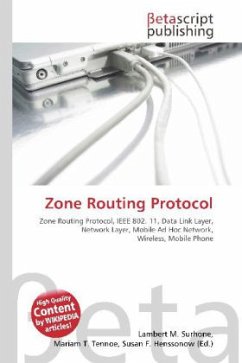
Zone Routing Protocol
Versandkostenfrei!
Versandfertig in 6-10 Tagen
30,99 €
inkl. MwSt.

PAYBACK Punkte
15 °P sammeln!
Please note that the content of this book primarily consists of articles available from Wikipedia or other free sources online. Zone Routing Protocol or ZRP was the first hybrid routing protocol with both a proactive and a reactive routing component. ZRP was first introduced by Haas in 1997. ZRP is proposed to reduce the control overhead of proactive routing protocols and decrease the latency caused by routing discover in reactive routing protocols. ZRP defines a zone around each node consisting of its k-neighbourhood (e. g. k=3). In ZRP, the distance and a node , all nodes within -hop distanc...
Please note that the content of this book primarily consists of articles available from Wikipedia or other free sources online. Zone Routing Protocol or ZRP was the first hybrid routing protocol with both a proactive and a reactive routing component. ZRP was first introduced by Haas in 1997. ZRP is proposed to reduce the control overhead of proactive routing protocols and decrease the latency caused by routing discover in reactive routing protocols. ZRP defines a zone around each node consisting of its k-neighbourhood (e. g. k=3). In ZRP, the distance and a node , all nodes within -hop distance from node belongs to the routing zone of node . ZRP is formed by two sub-protocols, a proactive routing protocol: Intra-zone Routing Protocol (IARP), is used inside routing zones and a reactive routing protocol: Inter-zone Routing Protocol (IERP), is used between routing zones, respectively. A route to a destination within the local zone can be established from the proactively cached routing table of the source by IARP, therefore, if the source and destination is in the same zone, the packet can be delivered immediately. Most of the existing proactive routing algorithms can be used as the IARP for ZRP.












